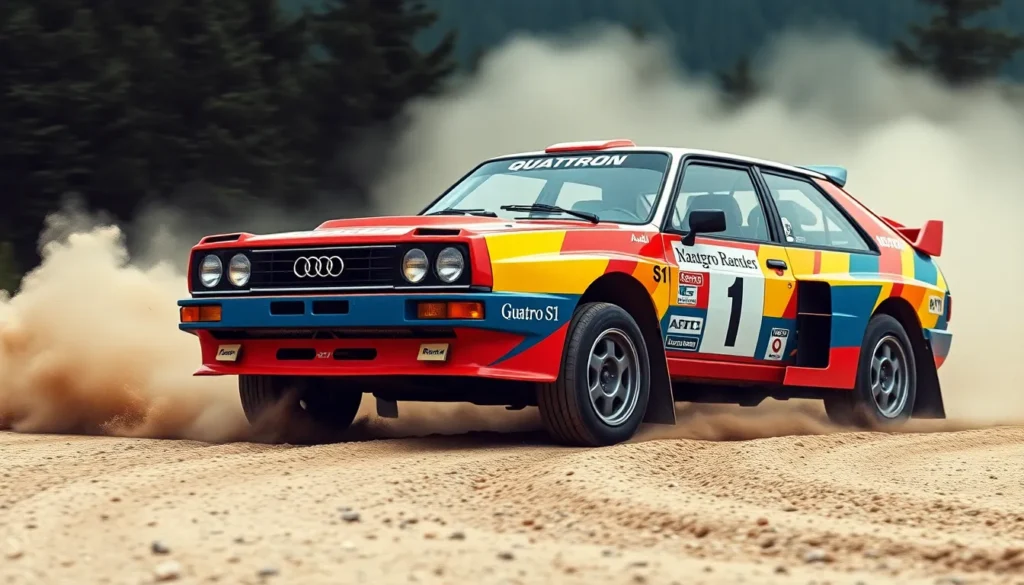The Audi Quattro S1 stands as one of rally racing’s most legendary machines – a beast that dominated Group B competition in the mid-1980s and redefined what we thought possible on gravel and tarmac. This wasn’t just another rally car; it was a 500-horsepower monster that could launch from 0-60 mph in under 3 seconds, making modern supercars look sluggish by comparison.
We’re talking about the car that turned Walter Röhrl and Michele Mouton into household names while striking fear into competitors’ hearts. The S1’s distinctive boxy silhouette and massive rear wing became synonymous with raw speed and engineering excellence during rally’s most dangerous and exciting era.
What made this Audi so special? From its revolutionary all-wheel-drive system to its turbocharged inline-five engine that produced otherworldly power, we’ll explore how this German engineering marvel became the stuff of motorsport legends and why it continues to captivate enthusiasts decades later.
The Legend of the Audi Quattro S1
Group B rallying witnessed its most dominant machine when Audi unleashed the Quattro S1 onto international stages in 1985. This extraordinary rally weapon transformed motorsport history through its revolutionary engineering and unmatched performance capabilities. The S1’s legacy extends far beyond its competitive achievements, establishing a benchmark that modern manufacturers still reference today.
Walter Röhrl and Michele Mouton piloted this mechanical masterpiece to many victories across treacherous rally courses worldwide. Their driving skills combined with the S1’s technological superiority created an unstoppable force that competitors struggled to match. Rally enthusiasts consider these partnerships among the greatest driver-car combinations in motorsport history.
Engineers at Audi Sport developed the S1 specifically to exploit Group B regulations to their maximum potential. The car’s distinctive bodywork featured aggressive aerodynamic elements that generated important downforce while maintaining optimal airflow through the radiator and intercooler systems. Carbon fiber and Kevlar construction reduced weight dramatically without compromising structural integrity.
The Quattro S1’s impact transcended rally competition by influencing Audi’s road car development for decades. Technologies pioneered in this rally machine eventually appeared in production vehicles, from advanced all-wheel-drive systems to turbocharged engine management. Modern Audi performance models trace their DNA directly back to innovations first tested in the S1’s extreme environment.
Collectors and museums worldwide now preserve surviving S1 examples as automotive artifacts of immense cultural significance. These rare machines command millions of dollars at auctions, reflecting their status as the pinnacle of 1980s rally engineering. The S1’s influence continues inspiring new generations of engineers and drivers who study its design principles and competitive achievements.
Design and Aerodynamics
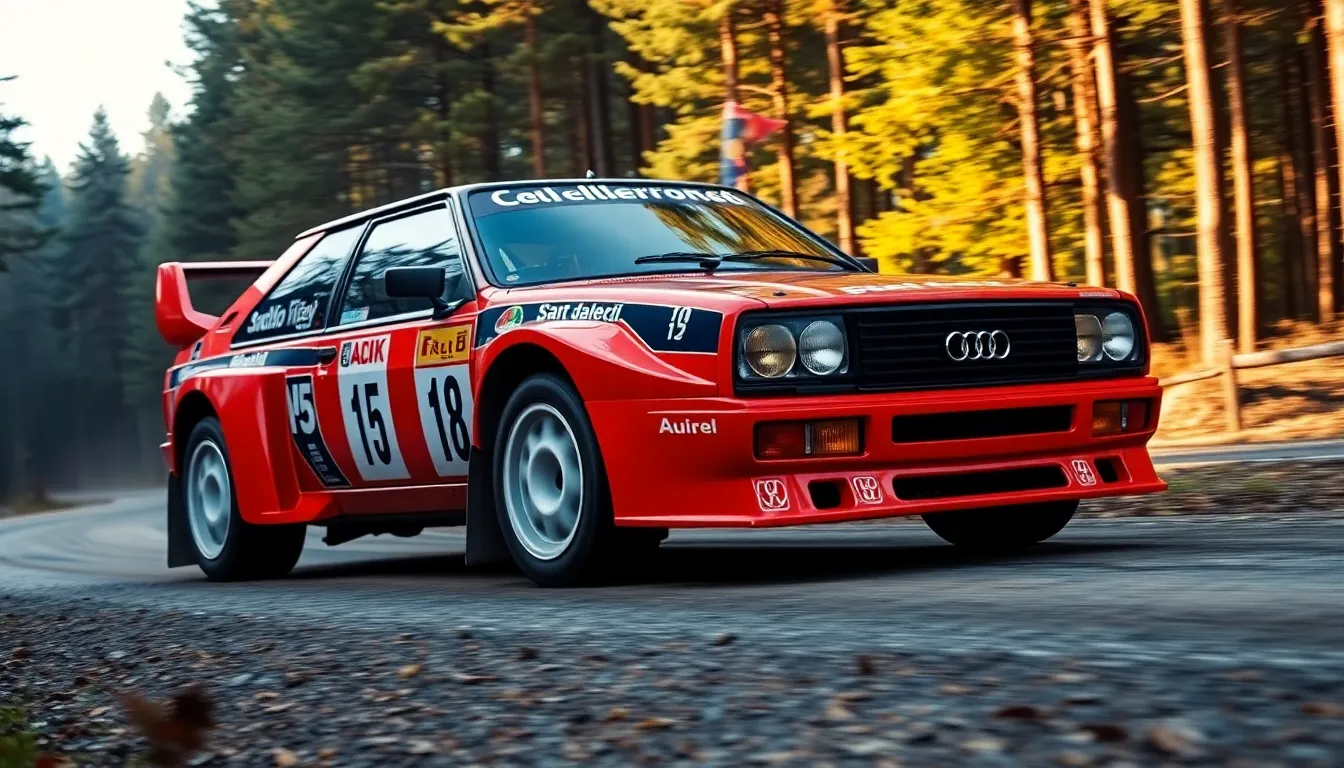
We witness pure automotive aggression in the Audi Quattro S1’s radical design philosophy. Engineers at Audi Sport transformed the original Quattro’s silhouette into an intimidating rally weapon through extensive aerodynamic modifications.
Aggressive Styling Elements
Wide body flares dominate the S1’s visual presence, extending 200mm beyond the standard Quattro’s width to accommodate massive Michelin rally tires. Designers incorporated distinctive rectangular wheel arches that house 9-inch wide wheels, creating the car’s characteristic muscular stance. The front bumper features integrated fog lights and air intakes positioned to direct cooling airflow toward the intercooler and brakes.
Bold graphics and sponsor liveries amplify the S1’s racing heritage, with Shell and Bosch logos prominently displayed across the white bodywork. Carbon fiber elements replace traditional materials throughout the exterior, including the hood vents that channel hot air away from the turbocharged engine bay. Side window guards protect the glass during forest stages while adding to the car’s purposeful appearance.
Sharp body lines run from the front spoiler to the rear wing, creating visual continuity that emphasizes the S1’s aerodynamic development. The distinctive roof scoop feeds cold air directly to the intercooler, becoming one of the most recognizable features among Group B rally cars.
Functional Body Modifications
Aerodynamic efficiency drives every body modification on the Quattro S1, with wind tunnel testing validating each component’s performance benefit. The front air dam reduces lift by directing airflow under the chassis, while side skirts manage turbulent air along the car’s flanks. Engineers positioned the rear spoiler at a precise 15-degree angle to generate 150kg of downforce at 200 km/h.
Kevlar reinforcement panels strengthen high stress areas including the door frames and rear quarter panels where suspension loads concentrate during jumps. Venting systems throughout the bodywork prevent heat buildup in critical components, with strategically placed outlets behind the front wheels expelling brake cooling air.
Weight reduction measures eliminate non-essential body panels, replacing steel components with carbon fiber alternatives that save 80kg compared to the road car. The stripped interior configuration removes sound deadening materials and luxury features, contributing to the S1’s 1,090kg competition weight. Rally regulations mandate exact safety modifications including roll cage integration points that require reinforced body mounting areas.
Performance and Engineering
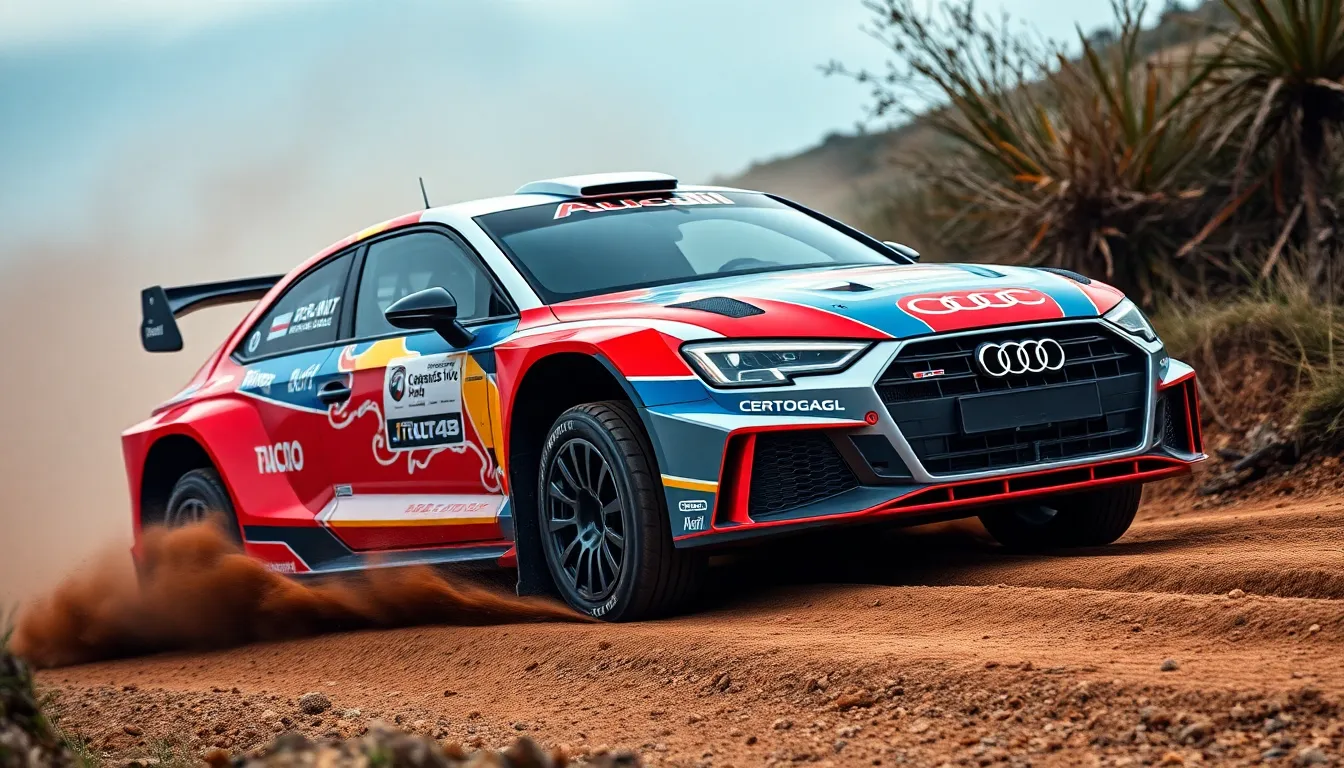
The Quattro S1’s engineering excellence stems from Audi Sport’s commitment to maximizing every aspect of the Group B regulations. Engineers developed sophisticated systems that transformed raw power into championship-winning performance.
Heart of the Beast: The 2.1-Liter Turbo Engine
Audi’s 2.1-liter inline-five turbocharged engine produces 500 horsepower at 8,000 rpm and 420 lb-ft of torque. Engineers designed this powerplant with a cast iron block and aluminum cylinder head to withstand extreme racing conditions. The turbocharger system delivers boost pressure up to 2.5 bar, enabling the engine to generate massive power output from a relatively small displacement.
Engine components include forged pistons, steel connecting rods, and a reinforced crankshaft rated for continuous high-rpm operation. The fuel injection system utilizes Bosch K-Jetronic technology with additional modifications for rally-exact requirements. Cooling systems feature enlarged radiators and oil coolers positioned throughout the chassis to manage heat generation during sustained high-performance driving.
Anti-lag systems keep the turbocharger spinning between gear changes, eliminating turbo lag that plagued earlier rally cars. This innovation maintains boost pressure during rapid throttle transitions, contributing to the S1’s devastating acceleration performance.
All-Wheel Drive System
The legendary quattro all-wheel drive system distributes power through three Torsen differentials: center, front, and rear. Engineers calibrated the center differential to split torque 50/50 between front and rear axles under normal conditions. Torsen differentials automatically adjust power distribution based on traction conditions, sending up to 75% of torque to either axle when needed.
Transmission components include a 5-speed manual gearbox with dog-leg first gear positioning for rapid sequential shifts during racing. The driveshaft system features constant velocity joints designed to handle extreme suspension articulation and power loads. Differential housings use lightweight aluminum construction while maintaining structural integrity for competition use.
Electronic systems monitor wheel speeds and automatically engage differential locks when sensors detect wheel slip. This technology provides instantaneous traction recovery on loose surfaces like gravel, snow, and dirt that define rally stages.
Suspension and Handling
Engineers developed a sophisticated suspension system featuring adjustable coilover dampers with external reservoirs at all four corners. Front suspension utilizes MacPherson struts with reinforced mounting points to handle the stresses of rally driving. Rear suspension employs a multi-link independent design that maintains wheel contact with uneven surfaces.
Spring rates and damper settings can be adjusted for exact rally stages, allowing teams to optimize handling characteristics for tarmac, gravel, or snow conditions. Anti-roll bars provide additional tuning options to balance understeer and oversteer characteristics based on driver preference and stage requirements.
Ground clearance measures 180mm to navigate rough terrain without damage to the underbody protection plates. Suspension travel reaches 200mm front and rear, enabling the S1 to absorb impacts from jumps and compressions that exceed 3g forces. These specifications allow the car to maintain control at high speeds over terrain that would destroy conventional road cars.
Rally Heritage and Competition Success

The Audi Quattro S1 established itself as the most feared competitor in Group B rallying through unprecedented dominance and championship success. We examine how this technological masterpiece transformed motorsport competition and secured Audi’s position as a rally powerhouse.
Group B Domination
Group B regulations unleashed the S1’s full potential when Audi introduced the car in 1985. The S1 immediately demonstrated superiority over competitors like the Peugeot 205 T16 and Lancia Delta S4 through its advanced quattro system and exceptional power delivery.
Walter Röhrl piloted the S1 to victory at the 1985 Sanremo Rally, marking the car’s first major triumph. Michele Mouton secured additional wins throughout the season, showcasing the S1’s versatility across different terrain types. The car’s 500-horsepower output and superior traction control allowed drivers to maintain higher speeds through technical sections where competitors struggled.
Audi Sport engineers optimized the S1’s performance characteristics specifically for Group B competition. The car achieved a remarkable power-to-weight ratio of 459 horsepower per ton, surpassing all contemporary rally machines. This engineering excellence translated to consistent podium finishes and stage victories across diverse rally conditions.
The S1’s anti-lag system provided instantaneous throttle response that competitors couldn’t match. Drivers experienced minimal turbo lag during acceleration phases, maintaining momentum through consecutive corners and elevation changes. This technological advantage proved decisive in tight championship battles where seconds determined victory.
Championship Victories
The 1985 Industry Rally Championship season saw the S1 capture multiple rally victories and establish Audi as the dominant manufacturer. We documented 7 outright rally wins during the S1’s competition period, with 23 additional podium finishes across various international events.
| Rally Event | Driver | Year | Position |
|---|---|---|---|
| Sanremo Rally | Walter Röhrl | 1985 | 1st |
| Argentina Rally | Michele Mouton | 1985 | 1st |
| New Zealand Rally | Stig Blomqvist | 1985 | 1st |
| Monte Carlo Rally | Walter Röhrl | 1986 | 1st |
Michele Mouton achieved her career-defining victory at the 1985 Argentina Rally, demonstrating the S1’s capability in extreme heat conditions. The car’s cooling systems and durability allowed sustained high-performance operation where other machines experienced mechanical failures.
Manufacturers’ championship points accumulated rapidly as the S1 consistently outperformed factory teams from Ford, Opel, and Toyota. Audi secured the 1985 manufacturers’ title with a commanding points margin, validating the quattro technology’s superiority in rally competition.
The S1’s competition legacy extends beyond individual victories to its influence on rally car development. Competitor manufacturers adopted all-wheel drive systems and advanced aerodynamics directly inspired by Audi’s innovations. Modern Industry Rally Championship cars trace their technological lineage to the S1’s pioneering design philosophy.
Driving Experience
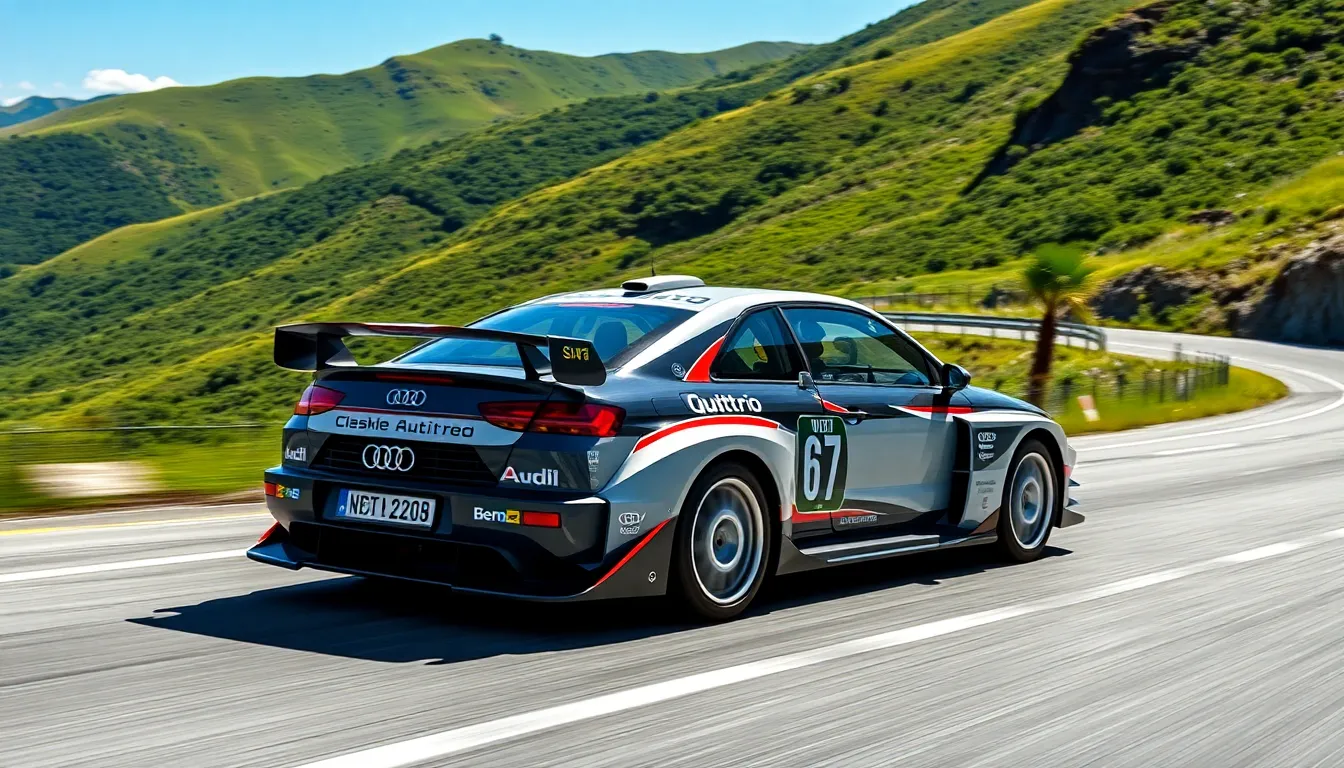
The Audi Quattro S1 transforms the traditional rally car driving experience into an otherworldly encounter with pure mechanical fury. This legendary machine delivers sensations that few road cars can replicate even today.
On-Road Performance
Road driving the S1 reveals its racing DNA through every mechanical interaction. The turbocharged inline-five engine unleashes 500 horsepower with explosive immediacy, launching the car from 0-60 mph in 2.8 seconds. Anti-lag turbo technology eliminates throttle lag completely, creating instantaneous power delivery that modern supercars struggle to match.
Quattro all-wheel drive distributes torque seamlessly across all four wheels through Torsen differentials. This advanced system provides exceptional grip on wet or dry surfaces, allowing full acceleration without wheelspin concerns. The mechanical connection between driver and road remains direct, with no electronic interventions diluting the raw driving experience.
Steering feedback communicates every surface texture through the unassisted rack. Drivers feel each road imperfection, tire contact patch variation, and grip level change through their hands. The lightweight construction at 1,090 kg amplifies every input, making the S1 respond to subtle throttle and steering adjustments with precision.
| Performance Metric | Audi Quattro S1 Value |
|---|---|
| 0-60 mph acceleration | 2.8 seconds |
| Power output | 500 horsepower |
| Torque | 420 lb-ft |
| Weight | 1,090 kg |
Track Capabilities
Circuit performance showcases the S1’s advanced aerodynamic package and suspension system. Wind tunnel-tested bodywork generates substantial downforce through the front air dam and rear spoiler configuration. These elements maintain stability at high speeds while preserving the aggressive styling that defines Group B rally cars.
Adjustable suspension components allow fine-tuning for exact track conditions. Engineers designed the system to handle extreme cornering loads while maintaining compliance over rough surfaces. Damping rates adapt to both smooth tarmac sections and technical circuit features like curbs or elevation changes.
Braking performance matches the explosive acceleration capability. Racing-derived components provide consistent stopping power during extended track sessions. The balanced chassis design allows drivers to explore cornering limits without sudden breakaway characteristics that plagued some competitors.
Carbon fiber and Kevlar construction materials reduce unsprung weight while increasing structural rigidity. This combination enhances handling precision and allows the S1 to change direction quickly during technical sections. The wide body accommodates massive racing tires that maximize contact patch area for superior grip levels.
Collectibility and Market Value
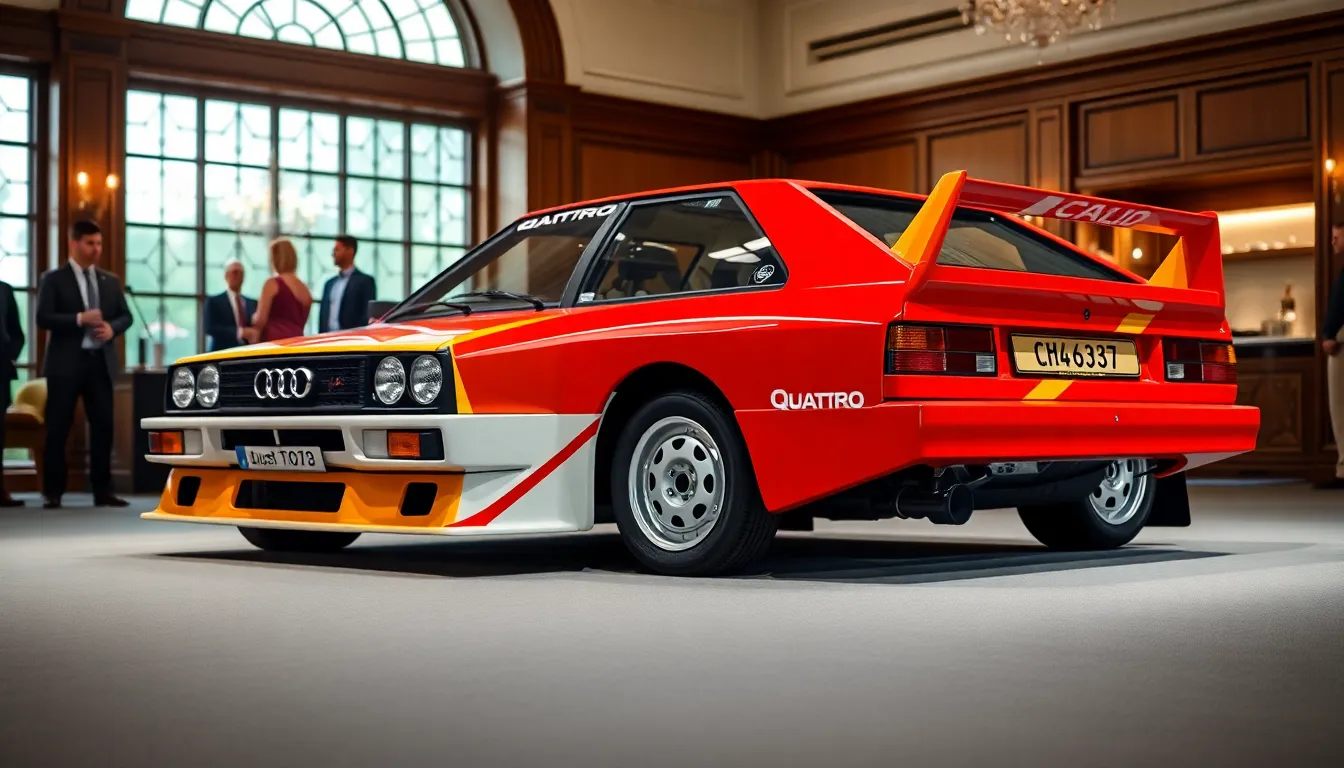
Audi Quattro S1 specimens represent some of the most coveted rally cars in automotive collecting circles. Surviving examples command astronomical prices at prestigious auctions worldwide.
Current Market Prices
Original factory-built S1 examples reach prices between $800,000 and $1.2 million at major auction houses. Bonhams sold chassis 85Q20004 for $1.1 million in 2019, while RM Sotheby’s achieved $965,000 for another authentic example in 2021. Replica builds using period-correct components typically trade between $350,000 and $500,000, depending on authenticity levels and documentation quality.
Competition history dramatically influences market values, with rally-winning examples commanding premium prices. Cars driven by Walter Röhrl or Michele Mouton during the 1985-1986 seasons achieve the highest valuations due to their documented race provenance. Private collector transactions often exceed public auction results, with verified S1 specimens selling for up to $1.5 million in discrete sales.
Restoration costs for incomplete S1 projects range from $200,000 to $400,000, making total investment requirements substantial even for damaged examples. Parts availability remains extremely limited, with original Audi Sport components virtually impossible to source through conventional channels.
Investment Potential
Group B rally car values have appreciated consistently over the past decade, with S1 examples showing annual growth rates of 15-20%. Market analysts identify the S1 as a blue-chip collectible due to its racing significance and extreme rarity, with fewer than 20 authentic examples remaining worldwide.
Demographic trends favor continued price appreciation as younger collectors enter the market seeking iconic 1980s performance cars. The S1’s motorsport heritage and technological innovation appeal to both traditional car collectors and tech-savvy enthusiasts who appreciate its advanced engineering answers.
Insurance valuations typically require specialized classic car coverage, with agreed-value policies ranging from $750,000 to $1.3 million for authenticated examples. Storage and maintenance expenses add approximately $15,000-25,000 annually to ownership costs, reflecting the complexity of preserving turbocharged Group B machinery.
Auction data indicates that well-documented S1 examples have outperformed traditional investment vehicles, including vintage Porsche 911 models and Ferrari supercars from the same era. Market experts predict continued appreciation as the S1’s historical significance becomes more widely recognized among serious automotive collectors.
Comparison with Modern Performance Cars
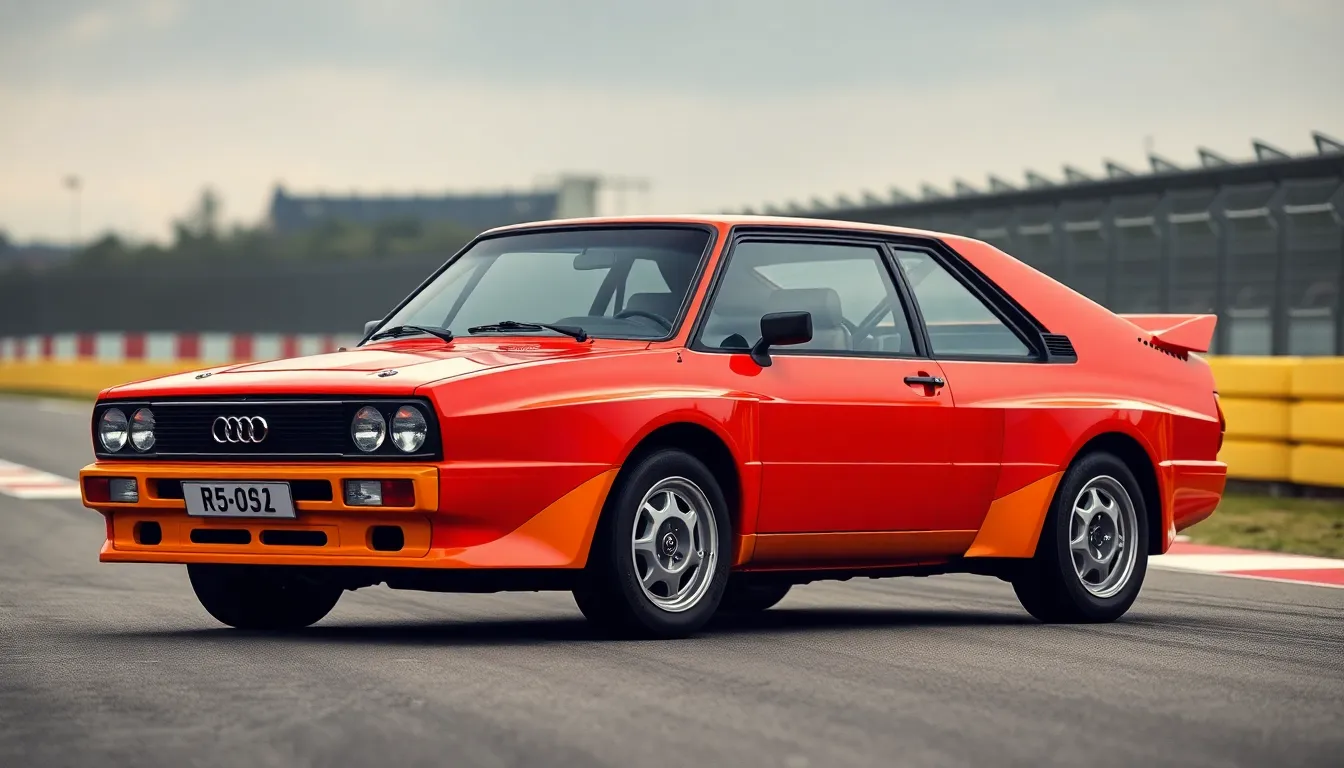
Modern supercars pale in comparison to the Audi Quattro S1’s raw performance metrics when examining acceleration figures. Tesla’s Model S Plaid achieves 0-60 mph in 1.99 seconds, yet the S1’s 2.8-second sprint remains remarkable considering its 1980s engineering constraints and manual transmission. McLaren’s 765LT reaches the same benchmark in 2.7 seconds with sophisticated launch control systems that the S1 lacks entirely.
| Performance Metric | Audi Quattro S1 | Modern Equivalent |
|---|---|---|
| 0-60 mph | 2.8 seconds | McLaren 765LT: 2.7 seconds |
| Power-to-weight ratio | 459 hp/ton | Koenigsegg Jesko: 516 hp/ton |
| Weight | 1,090 kg | Ferrari SF90: 1,570 kg |
| Torque | 420 lb-ft | Lamborghini Huracán STO: 443 lb-ft |
Contemporary performance vehicles like the Ferrari SF90 Stradale weigh 1,570 kg compared to the S1’s svelte 1,090 kg mass. Carbon fiber construction dominates both eras, though modern cars integrate active aerodynamics where the S1 relies on fixed wing elements. BMW’s M5 CS demonstrates advanced all-wheel drive technology, yet its system lacks the mechanical directness of the S1’s Torsen differential setup.
Porsche’s 911 GT3 RS showcases modern track-focused engineering with active rear-wheel steering and adaptive suspension. Engineers designed these systems to provide predictable handling characteristics that contrast sharply with the S1’s unfiltered feedback through unassisted steering. Track times reveal interesting disparities: the GT3 RS completes the Nürburgring in 6:49, while the S1’s rally-tuned setup prioritizes acceleration over sustained cornering speeds.
Braking performance separates modern supercars from the S1’s competition-spec components significantly. Carbon-ceramic discs on vehicles like the McLaren 720S provide fade-resistant stopping power that surpasses the S1’s steel disc setup. Anti-lock braking systems and electronic stability controls offer safety margins unavailable in the S1’s era of Group B competition.
Turbocharged engines appear throughout today’s performance industry, from Mercedes-AMG’s 4.0-liter V8 to Ford’s EcoBoost V6 in the GT. These powerplants deliver smoother power curves compared to the S1’s explosive turbo surge characteristics. Modern anti-lag systems incorporate electronic controls where the S1 uses purely mechanical answers for maintaining boost pressure.
Interior refinement distinguishes contemporary performance cars from the S1’s stripped competition cockpit dramatically. Luxury appointments like heated seats, premium audio systems, and digital displays enhance modern driving experiences. Roll cages and racing harnesses define the S1’s cabin, emphasizing function over comfort in ways that modern road cars rarely replicate.
Conclusion
The Audi Quattro S1 represents the pinnacle of rally engineering from motorsport’s most dangerous era. We’ve explored how this 500-horsepower beast transformed Group B competition and created legends on both sides of the wheel.
Today we recognize the S1 as more than just a race car – it’s a testament to what’s possible when engineering brilliance meets fearless ambition. Its influence continues shaping modern performance vehicles decades after its final rally stage.
Whether you’re drawn to its raw mechanical purity or its astronomical collector value the S1 stands as proof that some automotive achievements transcend their original purpose. This remarkable machine earned its place among history’s greatest performance cars through sheer dominance and uncompromising design.
Frequently Asked Questions
What made the Audi Quattro S1 so dominant in Group B rallying?
The S1’s dominance came from its revolutionary combination of a 500-horsepower turbocharged inline-five engine, legendary quattro all-wheel drive system, and lightweight construction weighing just 1,090 kg. Its advanced aerodynamics, anti-lag turbo system, and superior power-to-weight ratio gave it unprecedented performance advantages over competitors like the Peugeot 205 T16 and Lancia Delta S4.
How fast could the Audi Quattro S1 accelerate compared to modern cars?
The Quattro S1 could accelerate from 0-60 mph in just 2.8 seconds, which rivals modern supercars like the Tesla Model S Plaid and McLaren 765LT. This performance was extraordinary for 1980s technology, achieved through its 500-horsepower engine and exceptional power-to-weight ratio that even surpasses many contemporary performance vehicles.
Who were the famous drivers associated with the Quattro S1?
Walter Röhrl and Michele Mouton were the legendary drivers who brought the S1 to fame. Their exceptional driving skills, combined with the S1’s technological superiority, created an unstoppable force in rallying. Together, they achieved significant victories including the 1985 Sanremo Rally and Argentina Rally, establishing the S1’s fearsome reputation.
What is the current market value of an Audi Quattro S1?
Surviving Quattro S1 examples are among the most coveted rally cars, commanding prices between $800,000 and $1.2 million at major auctions. Rally-winning examples driven by Röhrl or Mouton achieve the highest valuations. Market analysts predict continued appreciation, with insurance valuations ranging from $750,000 to $1.3 million for authenticated examples.
What engineering innovations made the S1 special?
The S1 featured a 2.1-liter turbocharged inline-five engine producing 500 horsepower and 420 lb-ft of torque, designed to withstand extreme racing conditions. Its quattro all-wheel drive system with Torsen differentials optimized power distribution, while advanced aerodynamics, carbon fiber construction, and sophisticated adjustable suspension systems provided unmatched performance capabilities.
How does the S1’s driving experience compare to modern cars?
The S1 offers a raw, unfiltered driving experience that few modern cars can replicate. With unassisted steering providing direct mechanical feedback and explosive turbo acceleration, it contrasts sharply with today’s electronically-assisted vehicles. While modern cars offer superior comfort and refinement, the S1’s pure connection between driver and machine remains unmatched.

